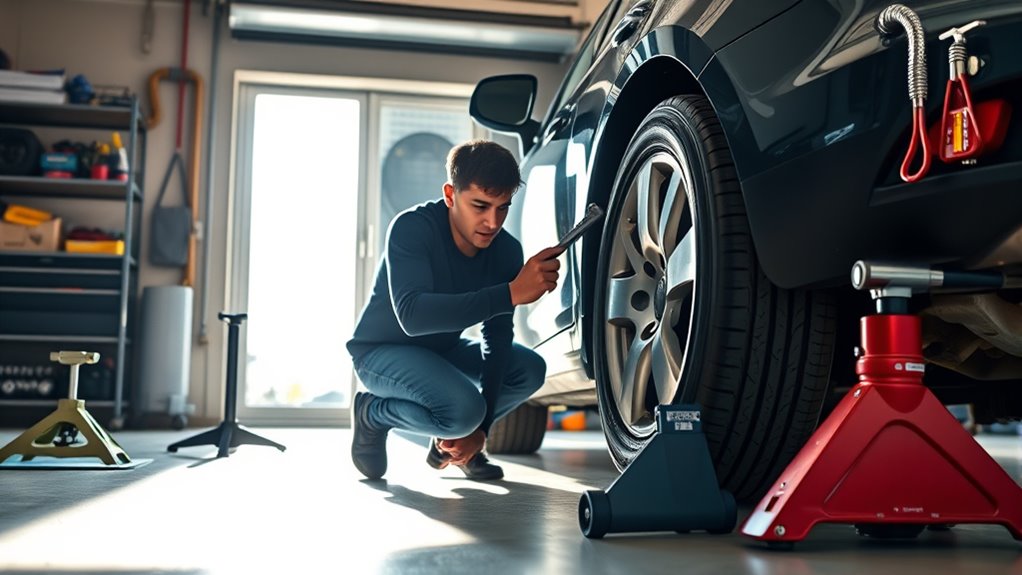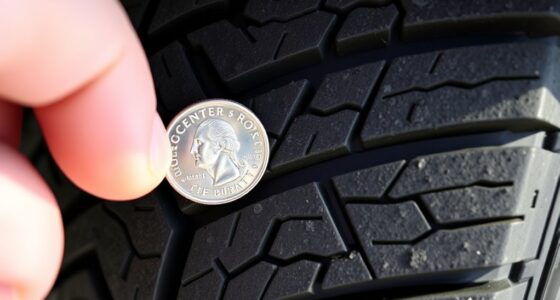To rotate your tires at home, start by parking on a flat surface and engaging the parking brake. Slightly loosen the lug nuts before lifting the vehicle with a jack at the manufacturer’s recommended points. Remove the wheels, then follow the specific rotation pattern for your vehicle type, such as front-to-rear or cross. Afterward, tighten the lug nuts to the proper torque, lower the vehicle, and double-check everything. For detailed steps, keep going to get all the tips you need.
Key Takeaways
- Familiarize yourself with the vehicle-specific tire rotation pattern from the owner’s manual before starting.
- Properly lift the vehicle using a jack at recommended lift points and secure it with jack stands.
- Remove wheels carefully, check for damage, and mark tires if needed to track original positions.
- Rotate tires according to the appropriate pattern for your vehicle type (front-to-rear, cross, etc.).
- After reinstalling wheels, tighten lug nuts to the manufacturer’s torque, lower the vehicle, and double-check all nuts for security.

Rotating your tires at home is a simple and cost-effective way to extend their lifespan and guarantee your vehicle performs safely. Proper tire rotation helps ensure even wear, which can improve handling, fuel efficiency, and overall safety. To do this successfully, you need to understand the right tire rotation techniques and be aware of common rotation mistakes that could undermine your efforts.
Rotating tires at home is an easy, cost-effective way to prolong their life and ensure safe vehicle performance.
First, familiarize yourself with the tire rotation patterns suitable for your vehicle. Most vehicles follow a front-to-rear or cross pattern, but it’s essential to check your owner’s manual for specific recommendations. For example, front-wheel-drive cars often require a different pattern than rear-wheel-drive or all-wheel-drive vehicles. Once you identify the correct pattern, you’ll be ready to begin the process.
Start by parking your car on a flat surface, engaging the parking brake, and chocking the wheels that won’t be lifted. Loosen the lug nuts slightly before lifting the vehicle with a jack. Make sure to position the jack under the manufacturer-recommended lift points. After raising the vehicle, remove the wheels carefully. When rotating the tires, pay attention to their condition—if you notice uneven tread wear or damage, address those issues before proceeding.
During the rotation process, remember that tire rotation techniques should follow the pattern appropriate for your vehicle type. For example, on a front-wheel-drive car, the front tires typically move straight back, while the rear tires cross over to the front. On other vehicles, the tires may all move straight across or follow a different pattern. Keep track of each tire’s position by marking them if necessary, so you can verify the rotation pattern.
Be cautious of common rotation mistakes that can cause problems down the line. For instance, neglecting to check and adjust your tire pressure afterward can lead to uneven wear or poor handling. Failing to tighten lug nuts to the manufacturer’s specified torque can cause the wheels to loosen or detach while driving. Also, rushing the process or skipping the cleaning of brake dust and debris can compromise the safety and balance of your wheels. Additionally, understanding the importance of tire maintenance can help you keep your tires in optimal condition longer.
Once you’ve completed the rotation, put the wheels back on, tighten the lug nuts in a star pattern, and lower the vehicle. After lowering, tighten the lug nuts fully to the proper torque specified by your vehicle’s manual. Finally, double-check everything—ensure all lug nuts are secure and that the tires are correctly installed. By following these tire rotation techniques and avoiding common mistakes, you can confidently rotate your tires at home, saving money and maintaining your vehicle’s safety and performance.
Frequently Asked Questions
Can I Rotate My Tires Without Jacking up the Car?
You can’t properly rotate your tires without jacking up the car because you’ll need to remove wheel lug nuts and lift the vehicle safely. Rotating tires involves changing their positions to promote even tire wear and maintain proper tire alignment. Without jacking up the car, you risk damaging the wheel or not completing the rotation correctly. Always make certain you follow safety precautions and use the right tools when working with wheel lug nuts.
How Do I Check Tire Tread Wear After Rotation?
Ever wonder if your tires are still safe? To check tire tread wear after rotation, look at the tire tread depth; use a tread depth gauge or the penny test. Also, perform a wear pattern analysis by inspecting for uneven tread wear, which signals alignment issues. If the tread is worn down to 2/32 inch or less, it’s time to replace your tires. Regular checks keep you safe and your car performing at its best.
What Tools Are Essential for At-Home Tire Rotation?
To rotate your tires at home, you’ll need a few essential tools. A jack and jack stands are vital for lifting your vehicle safely. You’ll also need a lug wrench to loosen and tighten wheel lug nuts. Don’t forget a torque wrench for proper tire alignment and securing lug nuts correctly. Having these tools on hand guarantees a smooth, safe tire rotation process and helps maintain ideal tire performance.
How Often Should I Rotate Tires for Optimal Performance?
Ever wondered how often you should rotate your tires for ideal performance? Following a consistent tire rotation schedule helps prevent uneven wear and extends tire life. Most experts recommend rotating your tires every 5,000 to 7,500 miles, but keep an eye out for signs of uneven wear like bald spots or vibrations. Regular rotations ensure your vehicle handles safely and efficiently, saving you money in the long run.
Is It Necessary to Balance Tires After Rotation?
After rotating your tires, it’s important to consider wheel balancing to ensure smooth driving and prevent uneven tire wear. While tire alignment is crucial for proper handling, balancing addresses minor weight differences that can cause vibrations. You should have your tires balanced after rotation to improve ride quality and extend tire life. Regularly checking both wheel balancing and tire alignment helps maintain ideal vehicle performance and safety.
Conclusion
So, there you have it—rotating your tires at home is easier than you thought. Who knew that a simple jack, some wrenches, and a bit of muscle could keep your car running smoothly? Now, instead of relying on pricey shop visits, you get to enjoy the thrill of DIY maintenance. Just don’t forget: your car probably appreciates the effort more than your bank account does. Happy rotating!









